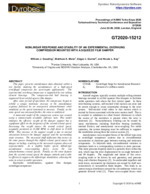Papers
“Nonlinear Response and Stability of an Experimental Overhung Compressor Mounted with a Squeeze Film Damper,” |
Abstract
This paper presents rotordynamic data obtained within a test facility studying the aerodynamics of a high-speed centrifugal compressor for aero-engine applications. The experimental overhung compressor is supported by two rolling element bearings. The compressor-end ball bearing is supported by an oil-fed squeeze film damper.
After some period of operation, the compressor began to exhibit a unique nonlinear increase in the rotordynamic response followed by an unexpected subsynchronous whirl instability as the speed continued to increase. Finally, as the rotor speed was increased further, the rotor re-stabilized.
A numerical model of the compressor system was created using a commercially available software suite. This model indicates the effective weight of the damper support has a significant effect on the frequency of the second critical speed. Increasing this weight causes the second critical speed, originally predicted at 35,200 RPM, to shift down to 15,650 RPM. This increase in the support weight is due to inertial interaction between the damper support and the surrounding static structure. The increased shaft deflection that occurs as the rotor passes through this shifted critical speed causes the damper to lockup, resulting in the increased response observed experimentally. At a slightly higher speed, Alford-type aerodynamic cross-coupling forces excite the two subsynchronous critical speeds. Finally, as the rotor departs from the second critical speed, the damper unlocks and is able to effectively suppress the Alford-type instabilities, allowing the rotor to return to stable operation.

